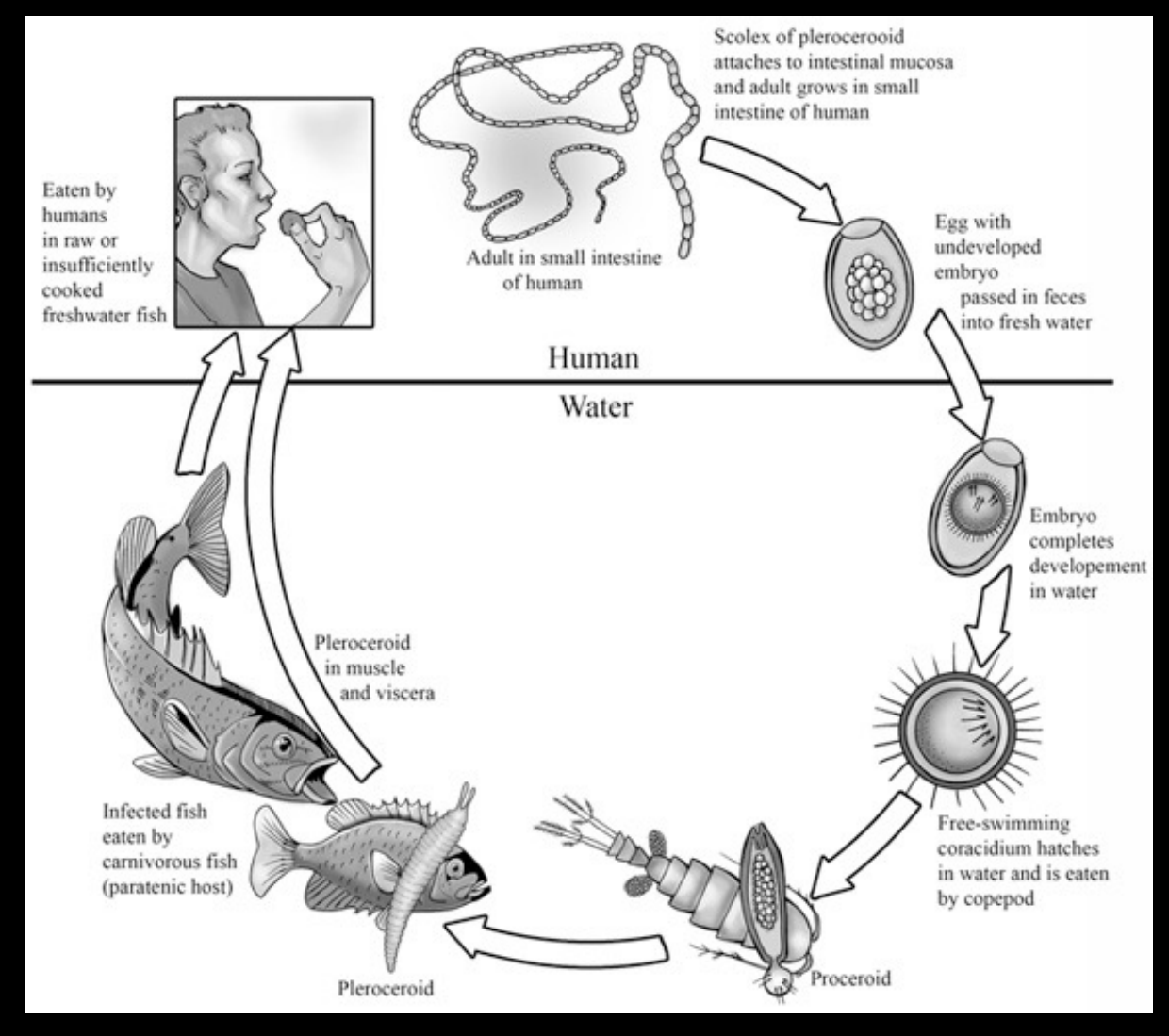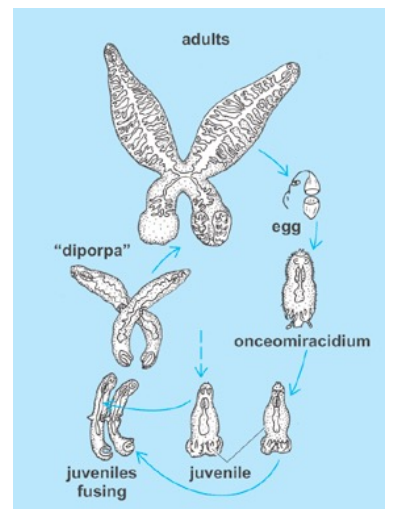Week 5: Platyhelminthes
1/53
There's no tags or description
Looks like no tags are added yet.
Name | Mastery | Learn | Test | Matching | Spaced |
|---|
No study sessions yet.
54 Terms
How many species are there?
60,000 +
Characteristics of Platyhelminthes
dorsal-ventrally flattened invertebrates
dominated by parasitic forms but large diversity of free living groups too
exhibit developmental plasticity, and regenerative/proliferative growth via the maintenance of somatic stem cells
found in marine, freshwater, terrestrial - as long as it is not arid- parasitic so within other animals
What are the 2 major areas of research on flatworms?
Parasites: Agents of Disease
agents of major neglected tropical diseases
causes economic loss in livestock production
e.g tapeworm
Free Living: Models of Regeneration/ Stem Cells
e.g planaria / some planaria → whole body regeneration
can also regenerate brain/ cephalic structures from even a single fragment of tissue
lesser forms of regeneration e.g posterior regeneration = a widespread feature within the whole group
What is whole body regeneration?
entire individual created from single adult stem cell
Phylogenetic position of platyhelminthes
historically thought to be early branching bilaterians → due to simple morphology
molecular data shows that they are a part of Lophophotrochozoans → not primitive
Which groups are now no longer considered to be flatworms?
Acoelomorphs, Nemertodermatida, Xenoturbella → thought to be early branching bilaterians
How do platyhelminthes excrete?
Excretion via protonephridia (a.k.a. 'flame cells') → specialised cell types scattered throughout parenchyma → use flagella to create a current and remove excess liquids
Habitat
freshwater, marine – open water, marine - interstitial, (damp) terrestrial, symbiosis, parasitism
^ essentially anywhere not arid → so that they don’t dry out
What is a tegument?
ciliated epithelium
protonephridia
simplified kidney system
Platyhelminthe Anatomy
Dorsal-ventrally flattened (ish…) → some exceptions
Hermaphroditic, rarely with separate sexes; reproduction via self- and cross-fertilisation → vast majority are hermaphrodites
Acoelomate (i.e. no body cavity): mesoderm gives rise to parenchyma, nerve/muscle and reproductive organs
essentially solid bodies filled with parenchymal cells
Digestive system typically a blind gut/sac (no digestive system in tapeworms)
most have a mouth but no anus
totipotent somatic stem cells
ability to give rise to any and all cell types
powerful for regeneration
Features Unique to Flatworms
Maintenance of totipotent somatic stem cells throughout ontogeny
the only totipotent stem cells are sperm/eggs in most animals
ALL new cells to support growth and homeostasis throughout ontogeny arise from the division of somatic stem cells (i.e. differentiated cells incapable of division)
differentiated cells divide to give rise to new cells of the same type in most animals
Somatic stem cells comprise ~1/3 of all cells in the body
differentiated cells comprise 99% of cells in most animals
Continual expression of axial patterning genes by the neural-musculature system throughout ontogeny, providing a molecular ‘road map’ for regenerating missing parts
axial patterning genes only expressed during embryogenesis in most animals
axial patterning genes
common + universally shared signalling systems normally found during embryogenesis
turn off once pattern is established
Planarians
Ubiquitous, cosmopolitan fresh-water invertebrates found in most ponds
Whole body regeneration in planarians
Some planarian species capable of regenerating the entire animal from a single somatic stem cell
Capable of reducing or enlarging overall body size in response to local resource availability
Can reproduce asexually via fission as well as sexually
The most important model organisms for understanding stem cell biology and regenerative medicine for almost 200 years (and counting)
Can regenerate brains
‘holy grail’ of planarian biology
how they know whether to regenerate a new head of tail – cracked in 2009: maintenance of Wnt signalling throughout ontogeny
Experimental disruption (‘knock down’) of Wnt signalling produces 2-head or 2-tailed phenotypes
Turbellarian flatworms
free living
Characteristics of turbellarian flatworms
Regenerative abilities widespread (but not WBR)
some microscopic groups found in between sand grains → freshwater
high diversity
Propensity for symbiosis
Neodermata
parasitic flatworms (obligate parasitism)
Major neodermatan groups
Trematoda (flukes)
Monogenea
Cestoda (tapeworms)
Do neodermata have a ciliated epidermis?
all flatworms have ciliated epidermis - true of neodermata larva but then they get ‘new skin’ and lose it
What are the 2 lineages of monogenea?
Monopisthocotylea → gill parasites/ blood feeders
Polyopisthocotylea → skin/ detritus feeders
Examples of flukes which cause large medical and economic impact
Blood flukes (schistosomiasis)
Human liver flukes (Clonorchis)
Cattle liver flukes (Fasciola)
Blood flukes (schistosomiasis)
280,000 deaths annually (no. 1 NTD)
schistosomiasis lives in blood system
male worm pairs with female and female lives inside groove of male together in permanent association
microscopic
chronic disease → damage caused is due to the way eggs migrate through the body through intestine/ bowels into environment
tiny eggs but 100s 1000s may be shed in a day
ultimately harms the tissues via migratory route over time
Water-borne disease with snail vectors
Neglected tropical diseases (NTD)
Neglected tropical diseases are a diverse group of tropical infections
Common in low-income populations in developing regions of Africa, Asia, and the Americas
They are caused by a variety of pathogens, such as viruses, bacteria, protozoa, and parasitic worms.
Why are blood flukes not a good example of a typical fluke?
separate sexes and this is very uncommon
live in blood system → most parasitic flatworms live in the gut if they are internal since that is where the nutrients are
Human liver flukes (Clonorchis)
30,000,000 infections
chronic disease
spread in flooded rice paddies → perfect environment for snails
snails as intermediate hosts
paddy fields → no sewage system → need a poo → if infected end up putting eggs back into that environment + perpetuating the life cycle
Cattle liver flukes (e.g. Fasciola) Economic losses
costs of anthelmintics, drenches, labor, liver condemnation at meat inspection
losses in production due to mortality, reduction in meat, milk and wool production
reduction in growth rate, fertility and draught power
What animals can the Cattle liver flukes (e.g. Fasciola) infect?
sheeps
goats
cattle
buffalo
other ruminants
Medical impact of tapeworms
Most severe when humans play the role of intermediate host rather than final and are infected with larval tapeworms instead of adult
tapeworms have indirect life cycles like flukes → less complicated
undergo a complete metamorphosis from the first larval stage to the next, then gives rise to adult
adults always in vertebrate host and generally invertebrate intermediate host e.g copepod in aquatic life cycle or beetles in terrestrial ones
most are tiny
chronic disease
Human Larval Cestodiases
larval infections - huge cause of epilepsy - don’t live in gut and have a tendency to go to the CNS
larval stage in CNS = dead end route for tapeworms
Neurocysticercosis- Taenia solium
Hydatid disease- Echinococcus multilocularis → cyst like structures
What is the difference between the damage caused by tapeworms and flukes in humans?
Tapeworm → humans as intermediate host = most damage
Flukes → adult stage = most damage to humans
How many species of Trematoda (flukes) are there?
~ 18,000
Characteristics of Trematoda
most diverse group of flatworms
Primarily enteric (i.e. intestinal) parasites of all vertebrate groups
Have major medical and economic importance
HIGHLY complex life cycles involving 3-5 hosts and multiple life stages
First host almost always a snail; less frequently bivalves, scaphopods and annelids
Both active and passive transmission strategies
Scientific name of the human blood fluke
Schistosoma mansoni
Difference in reproduction in tapeworms and flukes
each segment of a tapeworm has male + female reproductive organs→ thousands of eggs
flukes have rounds of asexual reproduction to ramp up the numbers
Features of human blood fluke
Disease: Schistosomiasis/Bilharziasis
Dioecious (separate sexes)
Blood dwelling → in venule/ arteriole system of human
Schistosome life cycle
miracidia (free-swimming/active penetration)
sporocyst (intra-mulloscan)
cercaria (free swimming/active penetration)
schistosomula (juvenile worm/active penetration)
miracidia (free-swimming/active penetration)
release eggs
eggs release enzymes and burrow out of venule and into lumen of intestine from which point they can leave the body
damage/ scar tissue/ pathology left- over a long time - organs damaged
sporocyst (intra-mulloscan)
once out- eggs hatch in water and can actively move and seek out a host - snail - has to be the right species relative to Schistosome
sporocyst = sac
undergoes asexual reproduction inside cell
cercaria (free swimming stage /active penetration)
2nd free living stage
fall down in water column and twitch tails to move them back up
encounters next host (human) by chance → burrows into human, drops off tail, juvenile in venule and matures to adulthood
schistosomula (juvenile worm/active penetration)
cercaria that dropped its tail
migrates through blood system
Presence of gut/ anus in flatworms vs. tapeworms
flatworms have a gut/ mouth , no anus
tapeworms have NO gut (hence no mouth) and thus obtain nutrients from the gut of their hosts via absorption across the outer tegument
How many species of cestoda are there?
~ 9000 species
Features of the parasitism of Cestoda
The majority are segmented (or ‘strobilated’)
Increase reproductive output via repetition of the reproductive organs
Enteric parasites of all major vertebrate groups
Have complex life cycles usually involving an arthropod 1st intermediate host→ copepod (always exceptions)
ALL transmission is passive via food webs
Host associations of tapeoworms
Elasmobranchs (sharks, rays, chimeras)
often adult tapeworms in marine environments in sharks
Teleosts
found in bony fish as adults but primarily in freshwater
Tetrapods (amphibians, reptiles, birds and mammals)
Broad-fish tapeworm (Diphyllobothrium latum)
bear tapeworm
humans can be definitive host
Broad fish tapeworm life cycle
1st stage larvae = ciliated- can swim in water column
actively predated on by copepod → metamorphose in haemocoel of copepod → juvenile worm
copepod eaten by fish
(small fish eaten by bigger fish)
fish eaten by human or a bear or something
unlike flukes- single egg in tapeworm generally gives rise to a single adult worm
larvae develop in gut - segmented worm

How many species of Monogenea are there?
~ 3,000 species
Features of Monogenea
External parasites of fishes (and some amphibians)
no species that infect humans
Direct (simple) life cycles
Mostly give birth to live young
hermaphrodites
exception to 2 lineages = group that parasitises amphibians
Economic importance of Monogenea
some economic importance, mainly to salmon farming in the UK and scandinavia
big problem → direct transmission i.e offspring just swim through water and find another host/ fish
can get to the point where they suffocate the gills of the fish or in any case just cause some damage
Example of parasite on fish gills e.g salmon
Gyrodactylus salaris
Example of extreme phenotypic plasticity
Diplozoon paradoxum
2 separate individuals have to find each other - tissues fuse into a single organism = sexual maturity
